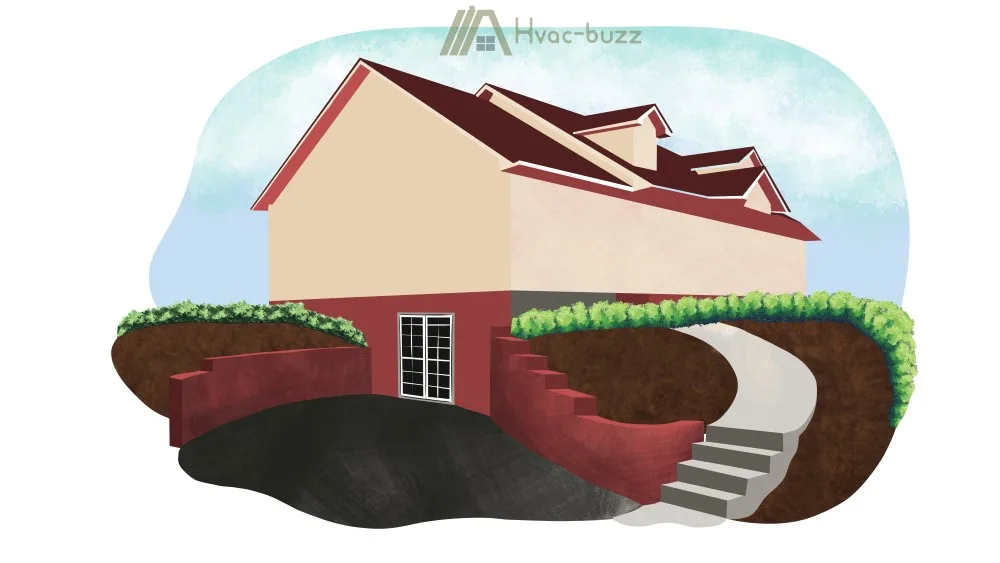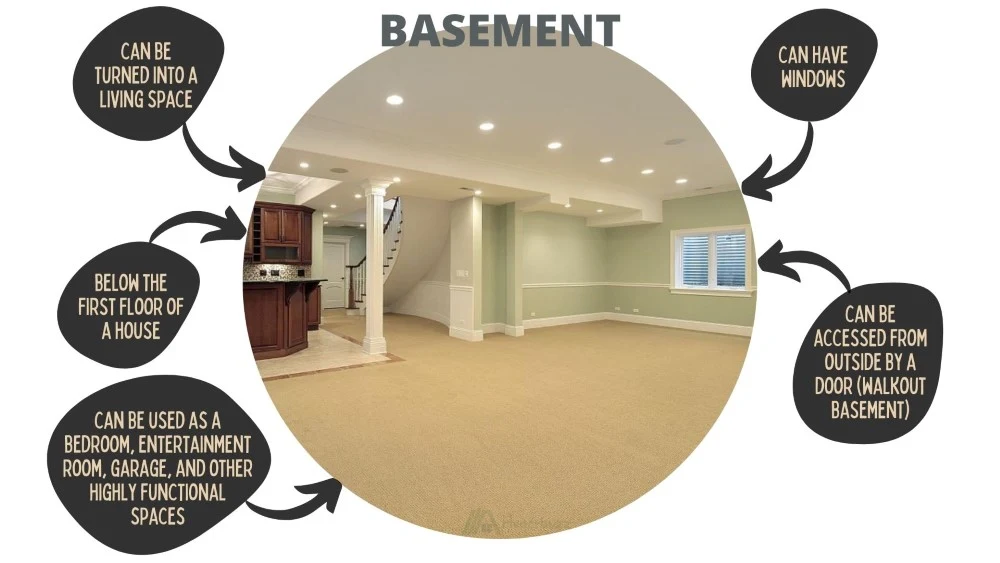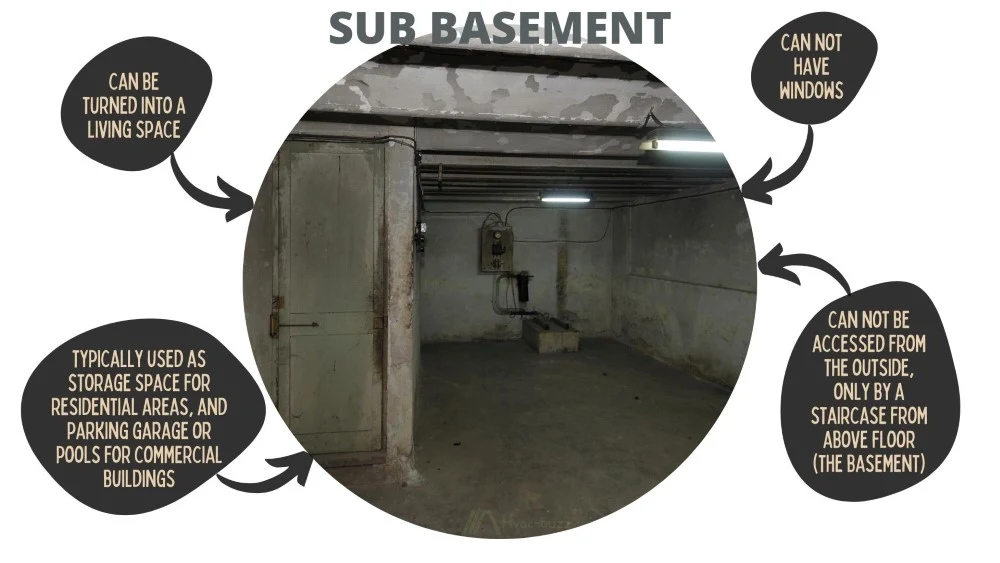Difference Between Basement and Sub Basement: Overview
A basement and a sub basement are similar in that they are both floors below the main floor of the house. They are also both often used for storage and/or placement of boilers or furnaces.
The most distinguishing difference between a basement and a sub basement is their depth. Yes, they are both below the main floor, but the sub basement is below the basement, and the basement is above the sub basement.
You can have a basement without having a sub basement below it, but a sub basement must have a basement above it.

A basement is the floor below the ground floor in a house. It can be used as storage or living space. A sub basement is the floor below a basement. It can be used for storage but not as living space. Houses can have basements without sub basements, but sub basements only exist if there are basements.
What is a Basement?
General Definition
A basement is the room or floor below the first (ground) floor of a household and has at least one wall completely surrounded by soil (completely underground). I say at least one wall because you get daylight and walkout basements, which are partially above ground.

Take a Detour
Difference Between Daylight and Walkout Basement
Basements have a fairly wide range of uses, including a garage, an in-home theater, a bedroom, a laundry room, a bar, a tool room, or just a space for storage.
Basements are so multifaceted because they are an added area of a home, meaning they are not required. Their installation depends on the region, for example, Californian homes seldom have basements. Areas with a high risk of flooding try to avoid basements but areas with the likelihood of tornadoes tend to install basements, or at least cellars, for shelter.
It is the homeowner’s choice whether they would like to finish the basement. It is also their choice as to what they would like to do with it. But remember, it is not your choice of whether you need a permit or not, so check carefully before you start any finishing work.

Living Space?
It is possible and legal to live in a basement but only with building code-approved egress points such as egress windows or other approved points of egress.
Depending on your personal preferences, basement living might prove more agreeable than living on the main floor, but the cons, given along with the pros in the article linked above, must be considered as well.
A walkout basement, a basement with at least one wall not submerged in the earth, is often more finished than a non-walkout basement and is more likely to be a living space. It allows for more sunlight to enter and has more accessibility than a normal basement.
Flooding
As is the case for all other underground facilities, there is a definite possibility of flooding in a basement. The risk is much lower, though, for walkout basements that are not fully underground.
What is a Sub Basement?
General Definition
A sub basement is a basement-like space completely underground and which is located below a regular basement. This regular basement can be either a walkout, daylight, or a fully submerged basement.
Sub basements are even less likely to be finished than regular basements because they are mainly used for storage.
Sub basements are also very rare in residential areas. If one was to be installed, the entire foundation would have to be restructured to accommodate for this space and still support the rest of the home.
They are, however, are more common in residential apartment-style buildings where they are used for parking garages or in hotels, where they are used for a swimming pool.
A sub basement cannot have doors with access to the outside and can also not have windows since it is fully underground. The only way to access this area would be with stairs from the regular basement.

Living Space?
Since a regular basement is able to have egress windows or another point of direct egress to the outside, it can be used as a living space. A sub basement, in contrast, does not have any means of egress other than its stairway to the basement. This is not a suitable exit in the case of an emergency, and as such, a sub basement cannot be lived in.
Other than the codes you wouldn’t be following by making the sub basement a living area, there are other reasons why a sub basement isn’t suitable for habitation. Sub basements are prone to flooding and are very rarely finished, making for an uncomfortable living space. It would also have absolutely no natural light, which can have adverse health effects.
Flooding
A sub basement is even more prone to flooding than a regular basement since it is deeper into the ground with more soil above it. This larger amount of soil can hold a larger amount of water, leading to increased chances of flooding.
This is the reasoning for why sub basements are rarely finished; they are easily flooded and to fully protect them from moisture penetration would be a job and a half!
Table of Differences Between Basements and Sub Basements
| Basement | Sub Basement |
| Windows: can have windows | Windows: cannot have windows |
| Access to outside: can be accessed from outside by a door (if a walkout basement) | Access to outside: not accessible from the outside, only by a staircase from above floor |
| Location: below the first floor of the home | Location: below the basement |
| Uses: bedroom, entertainment room, garage, etc. (many uses) | Uses: residentially as a storage space; commercially as a parking garage or hotel pool |
| Living: can live here | Living: cannot live here |
| Relative cost to build: low. It is common and done often enough for the cost to be not very high | Relative cost to build: high. It fundamentally changes the structure of foundation and very uncommon for residential areas |
| Reason they were built: for structural integrity, foundations must be built below the frost line creating an enclosed space that might as well use as living space | Reason they were built: for storage space, especially if the regular basement is used for other purposes |
| Likelihood to flood: depends on local climate, but is very possible | Likelihood to flood: depends on local climate, but even more likely than regular basement |
| Finished? depends on personal preference as well as if it is a walkout, but is somewhat likely | Finished? very unlikely |
| Temperature: about 50-60°F; more subject to change since it is closer to outside air and may be a walkout basement | Temperature: about 50-60°F; less subject to change since it is fully underground and not at all exposed to surface air |
Sources
https://homesteady.com/12616024/what-is-the-meaning-of-subbasement
https://www.nashvillesmls.com/blog/common-basement-types.html
